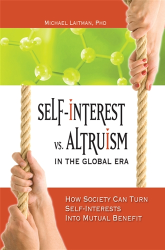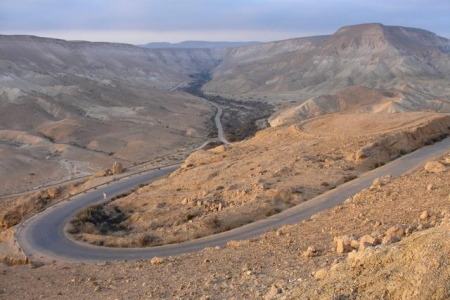Know the Law of Giving Like Abraham
When desires evolve in Nature, they create increasingly complex structures. Each new level rises to a higher degree of desire to receive when creatures of the current level join to form an aggregate of collaborators. By so doing, the creatures of the current (and presently highest) level create a system to which they can yield their self-interests, which provides them with sustainability and adherence to Nature’s law of giving. When this happens in humans, we, too, start from the smallest structure—a single person—and work our way toward increasingly complex societies. The only difference is that we must create these social structures that adhere to the law of giving by ourselves.
Abraham’s family was actually the first group to create that system, and then harness its members into a system whose parts were united by dedication to their host system. As Maimonides narrates, this initial system grew into a group. Yet, only in Egypt—when their number sufficed—did the system grow into a nation. When Moses brought Israel out of Egypt, the family of 70 that had gone into Egypt now consisted of several millions (there are many views on precisely how many came out of Egypt, but the common figures are between 2 and 6 million men, women, and children, excluding the mixed multitude).
Who Else Wants to Conquer Hatred?
Clearly, Moses’ job was far more challenging than Abraham’s. He could not gather the entire nation in his tent, as did Abraham with his family and few disciples, and teach them the laws of life. Instead, he gave them what we refer to as the Five Books of Moses, known in Hebrew as the Torah, which means both “Law” (of bestowal) and “Light.” In his books, Moses provided depictions of all the states that one experiences on the way to becoming like the Creator.
The first part of the way to emulating the Creator was to exit Egypt, venture into the Sinai Wilderness, and stand at the foot of Mount Sinai. According to ancient sources, the name, “Sinai,” comes from the Hebrew word, Sinaa (hatred). In other words, Moses gathered the people at the foot of Mount Sinai—the mountain of hatred.
To interpret the mountain-of-hatred allegory, Moses’ teachings showed the people how hateful they were towards each other, how remote they were from the law of bestowal. To reconnect with the law of bestowal, or the Creator, they united, as described by 11th century commentator and Kabbalist, Rashi, “As one man in one heart.”
Baal HaSulam elaborates on this process in his essay, “The Arvut (Mutual Guarantee),” where he explains that in return for their pledge to care for each other, Moses’ people were given the Torah. They attained the law of bestowal and obtained the light, the altruistic nature of the Creator. In Baal HaSulam’s words, “once the whole nation unanimously agreed and said, ‘We shall do and we shall hear,’ …only then did they become worthy of receiving the Torah, and not before.”
The First Mass Discovery of the Creator
Now we can see how important Moses’ mission was, and why free choice is a prerequisite to accomplishing it. The leaders of Abraham’s group were all family and were naturally united. But Moses had to unite a nation. To achieve that, the entire nation had to agree on a path. By making a free choice to unite, despite the evident egoism (allegorically described as “standing at the foot of Mount Sinai”), a nation was admitted into the law of giving. This was the first time in humanity’s history that people en masse attained the quality of the Creator, and from this point forward, choosing unity in the face of growing egoism will be the only way to achieve the Creator.
What Everybody Ought to Know about the Difference between the Path of Pain and the Path of Nature
The sages of the Talmud wrote, “one who has one hundred, wishes for two hundred.” Since the dawn of Kabbalah, its practitioners stated that our desires evolve. They grow in both intensity and quality, meaning not just how much we want, but also what we want. Eventually, these desires evolve to become the ultimate desire—to be like the Creator.
But Kabbalists have also stated that we have free choice in how we arrive at the greatest desire, which also yields the greatest pleasure. They said that there are two ways to reach this goal.
1. We follow Moses’ example and unite. We do that by studying how Nature works at its most fundamental levels, how we, being offshoots of the law of Nature operate, and then try to work like Nature, in unity, just as a child imitates its parents.
2. We ignore the available information and try to discover the secret to a good and sustainable life by ourselves. This can be compared to a child sitting behind the wheel of a car but is too small to see out the window. Naturally, this will result in recurring accidents with horrific consequences.
Kabbalists called the first, enlightened way, “The Path of Light,” and the second, torturous way, “The Path of Suffering.”
The evolution of desires occurs irrespective of our choices. When it is not accompanied by a calculated effort to unite and to choose the path of light in order to discover the law of giving, there is nothing to regulate the growing desire and funnel it in constructive directions. The result is increased and unchecked egoism. This is usually accompanied by “an accident”—disintegration and defeat as it happened in Babylon and in Egypt.
Do You Know Why Kabbalah Was Hidden for So Long?
Indeed, the history of the Israeli nation is the best example of this statement. As long as they followed Abraham’s teaching, they succeeded. When they did not, they were defeated and exiled.
Approximately 1,900 years ago, a new level of desire to receive emerged. This required a renewed effort and a renewed choice to unite. Yet, the people of Israel were not ready to make the effort. Instead, they fell into hatred and egoism. The Babylonian Talmud, written around the 5th century C.E., explains that the sole reason for the defeat of Israel and the ruin of the Temple was unfounded hatred.
Since that ruin, the world has had only one path to tread—the path of suffering. The path of light was known to very few individuals in the generations that followed, and every few decades they would warily try to expose it. But seeing that people were not yet ready to contemplate the truths that that path held about reality, they kept it to themselves and to those rare devoted students who sought the truth at all cost.
Yet, the years of obliviousness to Kabbalah were not in vain. They have given us much knowledge and myriad observations of Nature as a whole, and of human nature in particular. Without those years, the resumption of acceptance of the knowledge that Kabbalah provides would not be possible.
 “Why Kabbalah Can Help You Reveal the Creator Today” is based on the book, Self Interest vs. Altruism in the Global Era: How Society Can Turn Self Interests into Mutual Benefit by Dr. Michael Laitman.
“Why Kabbalah Can Help You Reveal the Creator Today” is based on the book, Self Interest vs. Altruism in the Global Era: How Society Can Turn Self Interests into Mutual Benefit by Dr. Michael Laitman.

